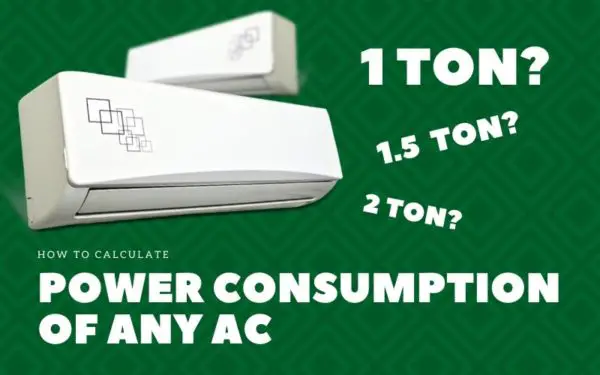
If you are planning to buy a new ceiling fan or wondering how much electricity your existing ceiling fan is consuming then this article is for you. In this article, we will calculate the power consumption of a ceiling fan and also look at how much it costs to use one.
Also by the end, you will learn to calculate the power consumption of any fan using a simple calculator.
Ceiling fans are normally rated between 25 watts to 80 watts. A 55 watt ceiling fan running for 8 hours in a day will consume around 0.44 kWh of electricity in a day. This adds up to around 13.20 kWh of electricity in a month.
Hence, the monthly electricity cost to run a 55 watt ceiling fan for 8 hours every day will be $ 3.40 in Los Angeles, £ 4.75 in London, and Rs 34 in Mumbai.
Ceiling Fan Power Consumption:
The power consumption of a ceiling fan (for that matter any electrical appliance) depends upon two main things,
- First is the wattage of your ceiling fan,
- And second is the electricity tariff in your area.
Before we jump into calculating the power consumption of your ceiling fan let’s see what these terms are and how you can find out your ceiling fan’s wattage and the electricity tariff of your locality.
If you already know these terms and just want to use the calculator then please scroll down to see the power consumption table and use the calculator.
What is the Wattage of A Ceiling Fan:
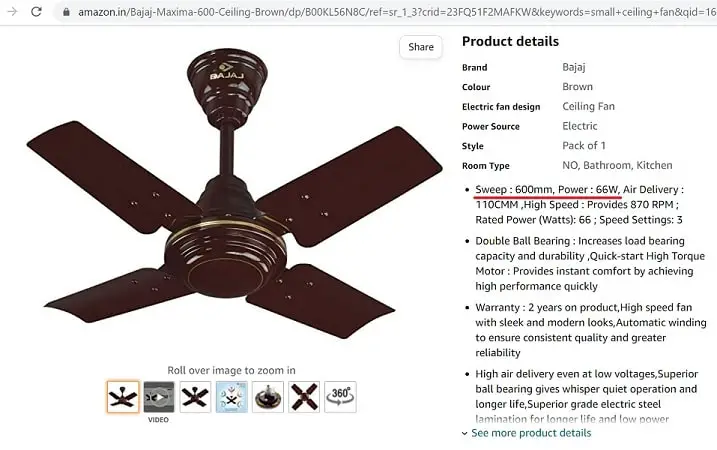
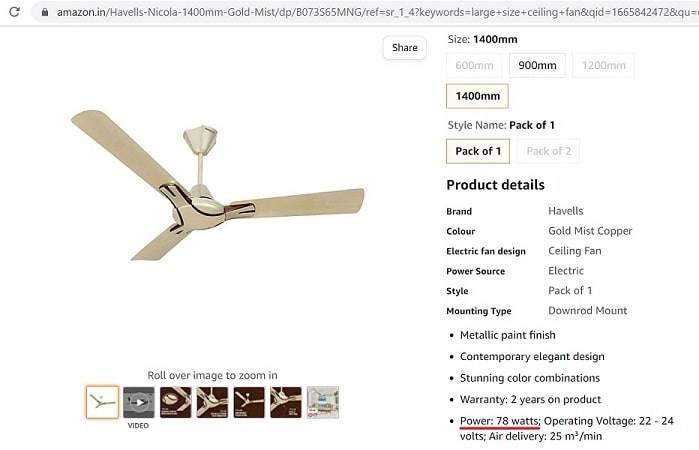
The wattage of a ceiling fan varies from 25 watts to 80 watts, generally, the bigger the blade size, the more air it can push forward, and the higher the wattage, thus higher the power consumption.
The wattage of a ceiling fan also depends on the type of motor being used, most ceiling fans use induction motors which are rated on the higher side from 50 watts to 80 watts.
However, nowadays there are fans with energy efficient Brushless Direct Current (BLDC) motors that consume half the power of induction motors. A BLDC ceiling fan is normally rated between 25 watts to 35 watts. (more on them in the later part of the article)
Also, the wattage of a ceiling fan varies from manufacturer to manufacturer, as you can see from the below images, the ceiling fan with a 1200mm (47″) sweep is rated at 56 watts, whereas the one with a smaller sweep of 900mm (35″) is rated at 68 watts. So there is no standard wattage for a particular size.


Hence, I would suggest you find the wattage of your ceiling fan by reading the label on it or just look for your ceiling fan on amazon or the manufacturer’s website and you will find its wattage in the description section.
Generally, the standard wattage range for ceiling fans is as follows.
| Sweep | Ceiling Fan Wattage |
|---|---|
| 900 mm (35″) | 50 watts to 60 watts |
| 1200 mm (47″) | 60 watts to 70 watts |
| 1400 mm (55″) | 70 watts to 80 watts |
At the end of this article, I have put together a table that shows the power consumption of a range of ceiling fans with different wattages.
If this whole talk about wattage and electricity is confusing you then here is a quick explanation about what is watt.
Watt is the unit of power. It means the rate at which electricity is consumed or produced by a device. For example, a 50-watt TV consumes power at a rate of 50 watts per hour, it does not mean that the TV consumed 50 units of electricity, it means it will consume power at a rate of 50 watts every hour.
So in short, the wattage of a ceiling fan lies between 25 watts to 80 watts and you can find it by looking at the label on it. With that out of the way, let’s look at what is electricity tariff.
What is your Electricity Tariff:
In simple words, electricity tariff is the amount your electricity provider charges you for one kWh (unit) of electricity. I live in Mumbai, India here the electricity tariff is Rs 12/kWh.
(What is a Kilowatt hour (kWh) – Kilowatt hour or unit of electricity is the energy consumption of a device. For example, a 50-watt fan running for 50 hours will consume 50 watts x 50 hours = 2500-watt hours = 2.5-kilowatt hours of electricity = 2.5 units of electricity. (1 kWh of electricity = 1 unit of electricity))
To find your electricity tariff, just look into your previous month’s electricity bill and find out your monthly electricity consumption, then just divide your monthly electricity consumption by your total monthly electricity bill, the figure you get is approximately your electricity tariff.
I have put together the following table that shows the electricity tariff of a few countries.
Electricity Tariff Around The World:
| Country | Electricity Tariff | Country | Electricity Tariff |
|---|---|---|---|
| United States | $ 0.154/kWh | India | Rs 6/kWh |
| United Kingdom | £ 0.27/kWh | Germany | € 0.44/kWh |
| Canada | C$ 0.30/kWh | Philippines | ₱ 9.70/kWh |
| Australia | A$ 0.32/kWh | South Africa | R 2.558/kWh |
You can also check out the following resources to know your electricity tariff:
- https://www.globalpetrolprices.com/electricity_prices/
- https://www.statista.com/statistics/263492/electricity-prices-in-selected-countries/
Calculate Ceiling Fan Power Consumption:
With these two pieces of information in hand, you are ready to find the power consumption of your ceiling fan.

Let me show you an example,
I have selected a 1200mm sweep, 56-watt ceiling fan listed on amazon. Let’s assume we will be using it for 8 hours every day throughout the year.
Hence, we will calculate the power consumption of this 56-watt ceiling fan in a day, in a month, and in an entire year.
With the knowledge of your ceiling fan wattage and your electricity tariff, just use this simple formula to calculate power consumption.
Power consumption of an appliance = Wattage of an appliance X operational hours
Cost to run an appliance = Power consumption of an appliance X electricity tariff.
(Operational hours is basically the number of hours you are using your ceiling fan)
Now let’s calculate
Electricity consumption of A Ceiling Fan:
In our case, wattage is 56-watt and operational hours are 8 hours in a day, 240 hours in a month, and 2,920 hours in a year.
Hence by using the above formula.
- Power consumption of a 56-watt ceiling fan in a day (8 hours) = 56-watt X 8 hours = 448 wh.
- Similarly, Power consumption of a 56-watt ceiling fan in a month (8 hours/day @ 30days) = 56-watt X 240 = 13.4 kWh.
- And Power consumption of a 56-watt ceiling fan in a year (8 hours/day @ 365 days) = 56-watt X 2,920 = 163.5 kWh.
Now that you know the power consumption just multiply it by your electricity tariff and you will get to know the cost you to run your ceiling fan.
let’s calculate how much it will cost to run this 56-watt ceiling fan for 8 hours every day for an entire month in Los Angeles, London, and Mumbai.
- In Los Angeles, the electricity tariff in Los Angeles is around 25.8 cents per kilowatt hour (kWh), hence it will cost around $ 3.46 (13.4 kWh X 25.8 cents) to run this 56-watt ceiling fan for 8 hours every day for an entire month.
- In London, the electricity tariff in London is around 36p/kWh, hence it will cost around £ 4.82 (13.4 kWh X 36p/kWh) to run this 56-watt ceiling fan for 8 hours every day for an entire month.
- In Mumbai, the electricity tariff in Mumbai is around Rs 10 per kilowatt hour (kWh), hence it will cost around Rs 134 (13.4 kWh X Rs 10) to run this 56-watt ceiling fan for 8 hours every day for an entire month.
For your reference, I have calculated the cost to run this 56-watt ceiling fan for 8 hours daily throughout the entire year in Los Angeles, London, and Mumbai.
| Country (Tariff) | Daily Power Consumption of a Ceiling Fan (56-watt @ 8 hours) | Monthly Power Consumption of a Ceiling Fan (56-watt @ 240 hours) | Annual Power Consumption of a Ceiling Fan (56-watt @ 2,920 hours) |
|---|---|---|---|
| Los Angeles (25.8 c/kWh) | 0.45 kWh, cents 7.22 | 13.4 kWh, $ 2.16 | 163.5 kWh, $ 26.36 |
| London (36p/kWh) | 0.45 kWh, pence 10.08 | 13.4 kWh, £ 3.02 | 163.5 kWh, £ 36.79 |
| Mumbai (Rs 10/kWh) | 0.45 kWh, Rs 2.80 | 13.4 kWh, Rs 84 | 163.5 kWh, Rs 1,022 |
The above figures show the approximate power consumption of a 56-watt ceiling fan, however, the actual power consumption will be 5% to 10% lower than this.
Also, every ceiling fan has 3 to 5-speed settings, hence, if you are using your fan at low speed then the power consumption will be lower than this.
How lower? From the calculation I did on my ceiling fan, the difference in the power consumption between the top speed and the lowest speed is as high as 50%.
How Much Electricity Does a Ceiling Fan Consume in 24 hours?
For your reference, I have made the below table which shows the power consumption of a range of ceiling fans having different wattages running for 24 hours every day for an entire month.
| Ceiling Fan Wattage | Daily Power Consumption (24 hours) | Monthly Power Consumption (720 hours) | Annual Power Consumption (8,760 hours) |
|---|---|---|---|
| 55 watts | 1.32 kWh | 39.40 kWh | 481.8 kWh |
| 65 watts | 1.56 kWh | 46.80 kWh | 569.4 kWh |
| 75 watts | 1.80 kWh | 54.00 kWh | 657.0 kWh |
As you can see, even if you run a 75-watt ceiling fan for 24 hours a day for an entire month, it will consume 1.80 kWh of electricity in a day and 54 kWh of electricity in a month.
How Much Does it Cost To Run A Ceiling Fan For 24 Hours?
From the above table, we can see that the cost to run a 75-watt ceiling fan for 24 hours a day will roughly be equal to:
- $ 0.46 in LA. (1.80 kWh X $ 0.258/kWh)
- £ 0.65 in London. (1.80 kWh X £ 0.36/kWh)
- Rs 18 in Mumbai, India. (1.80 kWh X Rs 10/kWh)
And the cost to run a 75-watt ceiling fan for 24 hours a day for an entire month will roughly be equal to:
- $ 13.93 in LA. (54 kWh X $ 0.258/kWh)
- £ 19.44 in London. (54 kWh X £ 0.36/kWh)
- Rs 540 in Mumbai, India. (54 kWh X Rs 10/kWh)
How Much Electricity Does a BLDC Ceiling Fan Consume in 24 hours?
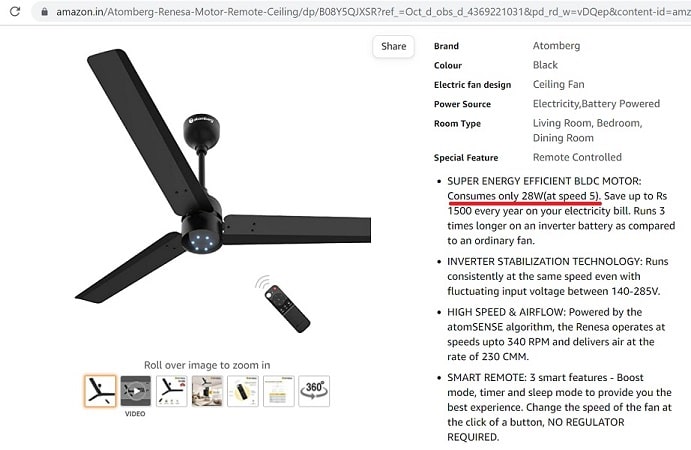

As you can see from the above images, for the same size, speed of rotation, and volume of air delivery, a regular ceiling fan with an induction motor consumes power at 56 watts, whereas a BLDC motor ceiling fan consumes power at just 28 watts.
For your reference, I have made the below table which shows the power consumption comparison between a regular ceiling fan and a BLDC ceiling fan.
| Ceiling Fan Wattage | Daily Power Consumption (24 hours) | Monthly Power Consumption (720 hours) | Annual Power Consumption (8,760 hours) |
|---|---|---|---|
| 28 watts (BLDC) | 0.67 kWh | 20.16 kWh | 245 kWh |
| 56 watts (Regular) | 1.34 kWh | 40.32 kWh | 491 kWh |
As you can see, even if you run a 28-watt BLDC ceiling fan for 24 hours a day for an entire month, it will consume 0.67 kWh of electricity in a day and 20.16 kWh of electricity in a month.
Whereas, a regular fan of the same size will consume 1.34 kWh of electricity in a day and 40.32 kWh of electricity in a month.
Clearly, BLDC fans consume half the electricity consumed by regular fans.
How Much Does it Cost To Run A BLDC Ceiling Fan For 24 Hours?
From the above table, we can see that the cost to run a 28-watt BLDC ceiling fan for 24 hours a day will roughly be equal to:
- $ 0.17 in LA. (0.67 kWh X $ 0.258/kWh)
- £ 0.24 in London. (0.67 kWh X £ 0.36/kWh)
- Rs 6.7 in Mumbai, India. (0.67 kWh X Rs 10/kWh)
And the cost to run a 28-watt BLDC ceiling fan for 24 hours a day for an entire month will roughly be equal to:
- $ 5.20 in LA. (20.16 kWh X $ 0.258/kWh)
- £ 7.25 in London. (20.16 kWh X £ 0.36/kWh)
- Rs 201 in Mumbai, India. (20.16 kWh X Rs 10/kWh)
Clearly, you can see it will cost half the amount to run a BLDC ceiling fan of the same size with the same speed and air delivery as a regular fan.
Now go ahead and use the below calculator to find out the power consumption of your ceiling fan.
Just type the wattage of your ceiling fan, the number of hours of usage, and your electricity tariff, and let the calculator do the math for you.
Ceiling Fan power consumption calculator:
As I said before, the above-calculated values are approximate figures and the actual power consumption will depend on the speed setting of your fan. The calculated values are definitely on the higher side, you can expect actual power consumption to be 10% – 20% lower.
You can check out this article to know more about the power consumption of all types of fans, How much power does a fan consume?
or check the following articles to know the power consumption of common household appliances in detail:
- Power consumption of a pedestal fan.
- Power consumption of a table fan.
- Power consumption of a ceiling fan.
- Power consumption of an air cooler.
- Power consumption of an AC.
- Power consumption of an electric fireplace.
- Power consumption of a refrigerator.
- Power consumption of a dehumidifier.
- Power consumption of an electric blanket.
- Power consumption of a washing machine.
If your house electricity bill is high then check out this article – Why my electricity bill is high? and how to rectify it.
You can check out this article to know more about the power consumption of common household appliances.
Check out my articles on solar power for home and how it can help you save your electricity bill.
Thank you for reading.
Aavjo 👋
- Double Door Refrigerator Power Consumption
 Share the article In this article, we will see double-door refrigerator’s power consumption and the cost… Read more: Double Door Refrigerator Power Consumption
Share the article In this article, we will see double-door refrigerator’s power consumption and the cost… Read more: Double Door Refrigerator Power Consumption - How to reduce air conditioner power consumption
 Share the articleSummer is here, and that means one thing: air conditioners are turned up to… Read more: How to reduce air conditioner power consumption
Share the articleSummer is here, and that means one thing: air conditioners are turned up to… Read more: How to reduce air conditioner power consumption - How To Save Electricity At School
 Share the articleElectricity consumption in schools is mainly because of two main sources of power consumption… Read more: How To Save Electricity At School
Share the articleElectricity consumption in schools is mainly because of two main sources of power consumption… Read more: How To Save Electricity At School - How To Reduce Power Consumption Of A Refrigerator?
 Share the articleIn this article, we will see how you can reduce your refrigerator power consumption… Read more: How To Reduce Power Consumption Of A Refrigerator?
Share the articleIn this article, we will see how you can reduce your refrigerator power consumption… Read more: How To Reduce Power Consumption Of A Refrigerator? - How To Calculate Power Consumption Of Any Appliance
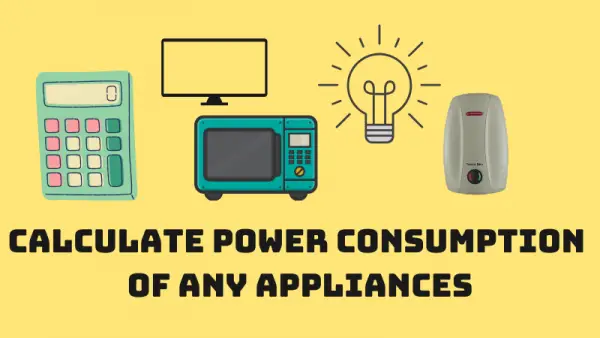 Share the articleEver wonder how much electricity the light bulb in your kitchen consumes or how… Read more: How To Calculate Power Consumption Of Any Appliance
Share the articleEver wonder how much electricity the light bulb in your kitchen consumes or how… Read more: How To Calculate Power Consumption Of Any Appliance - Top Load Vs Front Load Washing Machine
 Share the articleThe biggest question that came to my mind while choosing a washing machine last… Read more: Top Load Vs Front Load Washing Machine
Share the articleThe biggest question that came to my mind while choosing a washing machine last… Read more: Top Load Vs Front Load Washing Machine
References:
- https://www.globalpetrolprices.com/electricity_prices/
- https://www.statista.com/statistics/263492/electricity-prices-in-selected-countries/





